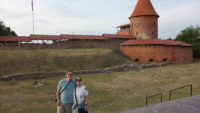 We left Vilnius behind, and we felt pretty good about our time there. There were a few more things I would have liked to see, but we hit all the big things. We had to get back to the airport to pick up the car, and that went pretty well once we found a backup route to the airport. We missed the quick bus to the airport by a minute (we saw it pull away), and the next one was inexplicably over an hour wait. We walked five minutes to the next stop and got a slower bus.
We left Vilnius behind, and we felt pretty good about our time there. There were a few more things I would have liked to see, but we hit all the big things. We had to get back to the airport to pick up the car, and that went pretty well once we found a backup route to the airport. We missed the quick bus to the airport by a minute (we saw it pull away), and the next one was inexplicably over an hour wait. We walked five minutes to the next stop and got a slower bus.
Getting the car was easy, and getting out on the road was fine. We have a European GPS, so navigating is easy. The car is a six-speed stick shift, and I would have preferred an automatic, but that isn’t too bad. Things were great until we got to suburban Kaunas, which is Lithuania’s second biggest city, with 300,000 people. But let’s go to the country first.
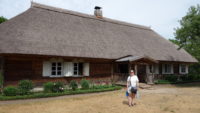 Our first stop was the Rumšiškės Open-Air Museum, which is a folk museum of saved buildings from all across the country. Most date from 1850 to 1930, but there were a few dating back into the 1700s as well. Mer and I like folk museums, and have been to more than half a dozen in Europe and the U.S.
Our first stop was the Rumšiškės Open-Air Museum, which is a folk museum of saved buildings from all across the country. Most date from 1850 to 1930, but there were a few dating back into the 1700s as well. Mer and I like folk museums, and have been to more than half a dozen in Europe and the U.S.
This was a bit of a different experience. We got to the ticket window and got into the museum, but couldn’t see any buildings. I had been handed a map that was in Lithuanian, but did have distances along paths in meters. I couldn’t help but notice that most of the distances between building clusters was marked with hundreds of meters. The place was huge. Ridiculously huge. And the buildings were organized by region (west, southwest, etc.), but even in the regions, the buildings were far apart. I’m not sure if it was to prevent a fire from spreading if it broke out, but it resulted in a lot of walking. I think I had us in at over five miles in the museum, and we only saw about three quarters of the buildings.
 That was okay, actually. Meredith had noted in the folk museum in Scotland that the differences in the living spaces of rural people went largely unchanged over hundreds of years. This was true here as well – farmhouses were built of wood in the early 1800s and had thatched roofs, and so did many farmhouse built in 1920. Rich farmers had wooden floors (and one even had wallpaper over the log walls), and poorer farmers had dirt floors. There were out-buildings for animals and storage, and the grounds around the living houses were tidy and pretty with flowers. Several of the homes were open to visitors, but many we could only see from the outside. We couldn’t talk to any of the docents because they didn’t speak English, so we had fun guessing what things could have been used for, or why things were certain ways. I’m sure we were right, given our vast expertise in nineteenth-century farming techniques.
That was okay, actually. Meredith had noted in the folk museum in Scotland that the differences in the living spaces of rural people went largely unchanged over hundreds of years. This was true here as well – farmhouses were built of wood in the early 1800s and had thatched roofs, and so did many farmhouse built in 1920. Rich farmers had wooden floors (and one even had wallpaper over the log walls), and poorer farmers had dirt floors. There were out-buildings for animals and storage, and the grounds around the living houses were tidy and pretty with flowers. Several of the homes were open to visitors, but many we could only see from the outside. We couldn’t talk to any of the docents because they didn’t speak English, so we had fun guessing what things could have been used for, or why things were certain ways. I’m sure we were right, given our vast expertise in nineteenth-century farming techniques.
The most unusual buildings were the two churches – one was a small rural church, and the other was a reconstructed village church, but both were octagonal in shape. I don’t remember seeing that before.
 We ate waffles in the 1900s village, where the twelve-year-old girl translated our order to her mother for us. We then headed back to the car. We had spent over three and a half hours at the museum.
We ate waffles in the 1900s village, where the twelve-year-old girl translated our order to her mother for us. We then headed back to the car. We had spent over three and a half hours at the museum.
And then on to Kaunas. I was trying to get us to Pazaislis Monastery, which is about six miles from the center of town. We were supposed to get there at 3:30, but that would be enough time, since they were open until 5:00. Then, three miles from our destination, we hit stopped traffic. There was road construction, and they were only letting a few cars through, and only every few minutes. After sitting more or less in the same spot for ten minutes, I tried a different route. One that took me through… The Rotary of Death.
On our detour, we had gotten close once again, and had successfully managed several roundabouts (or rotaries, as Mainers call them). No sweat. I came up on a large one, but guessed I had to be in the middle lane of three. Mostly right. The Rotary of Death doesn’t play by normal rules. Three lanes go in. One peels off. I feel smug for being in the right lane. My lane suddenly ends, so I make a quick dash into the inner lane, which is stopped because someone wants to leave The Rotary of Death by going straight out of The Rotary of Death, but that cuts across two new incoming lanes. I cut around that mess when my GPS demands I exit, but that requires cutting across two lanes of traffic. I made the first one, but an incoming car cut me off from the second lane, and I had to abandon the attempt. Then The Rotary of Death channeled me off, so I couldn’t have dreams of going around again.
Needless to say, I was flustered, and pulled into a parking lot that turned out to be for an old fort now stocked with twentieth-century military equipment. Sadly, the fort was closed, but I’d calmed down by the time I read about it and looked at the machines I could see. I determined to give The Rotary of Death one more try, and then to give up if I couldn’t make a NASCAR-style driving maneuver. This time it worked.
Smooth sailing now to the monastery! Oh, right – this is suburban Kaunas. My GPS told me to go left, but the local sign said to go right. My GPS was correct. That required a turnaround a half mile past my turn.
 All of which it to say we got to the monastery at 4:15. We still went inside, of course – we had come too far to go back empty-minded. We had to ask at the upscale hotel desk that was in the front hall of the complex where the entrance to the church was, and after a little confusion (“This is not it – you need to go outside”), we were in.
All of which it to say we got to the monastery at 4:15. We still went inside, of course – we had come too far to go back empty-minded. We had to ask at the upscale hotel desk that was in the front hall of the complex where the entrance to the church was, and after a little confusion (“This is not it – you need to go outside”), we were in.
We were checked in by a sweet lady with a high but melodious voice. I told Mer I stopped listening to the words so that I could let the sounds just wash over me, and she agreed. The woman could come home with us and read the sides of our cereal boxes and we’d be happy. The actual monastic complex open to the public was small – two courtyards, the church, and a side hall with a display on the history of the place.
The church was fun – we went in and were confronted with an open hole in the floor, with an uneven staircase into darkness. I went down, of course. Mer followed me when I yelled up that it was okay. It was a crypt, and the kind of one you’d expect with the word “crypt.” There were a couple of holes open in the wall with boards sticking slightly out where there was a carved board where a head would rest. It was clearly for a dead body. What little writing we could make out from the plaster covering the other graves seemed to show that these men died in the 1700s.
The church itself was highly decorated, but not in an over-the-top Baroque sort of way. It had many decorations where the action above, which was usually earthbound (not in heaven), was being seen by us from below, as if we were looking up out of a pit. We hadn’t seen that before except for when looking up into “heaven.” It was a bit unsettling to imagine where were were supposed to be looking up from.
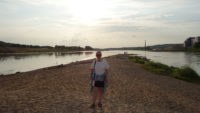 The history of the property was probably interesting, but we had to skim most of it because of time. It seems the monastery went from Catholic men to Orthodox men to Catholic women. Even from some things we read during our couple days in Vilnius, we had guessed that Lithanian has no separate word for “convent” – women, too, lived in a “monastery.”
The history of the property was probably interesting, but we had to skim most of it because of time. It seems the monastery went from Catholic men to Orthodox men to Catholic women. Even from some things we read during our couple days in Vilnius, we had guessed that Lithanian has no separate word for “convent” – women, too, lived in a “monastery.”
We left at 5:00 and drove into Kaunas. I’m guessing I had the city’s respect by then, having survived The Rotary of Death, because the drive in wasn’t too bad (one white-knuckle ordinary rotary moment of a sudden stop for a pedestrian). Our hotel has parking, so I left the car in the lot and looked forward to a car-free evening.
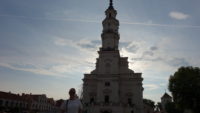 After supper, we took a walk through the Old Town of Kaunas. It was smaller than the one in Vilnius, but its main street was wider and filled with restaurants the entire way, which on a Friday felt festive. The main street dumped us into the huge square around the town hall, and again it was alive with people eating outside of restaurants.
After supper, we took a walk through the Old Town of Kaunas. It was smaller than the one in Vilnius, but its main street was wider and filled with restaurants the entire way, which on a Friday felt festive. The main street dumped us into the huge square around the town hall, and again it was alive with people eating outside of restaurants.
I wanted to see the castle remains, so we walked west toward a park. What a park! It had everything, and everything was being used by playing people: many basketball courts, outdoor ping pong tables, a huge playground, a full-sized track, a soccer field, an outdoor workout area with machines, open spaces for picnics, a kiddie playground, and more. There were people everywhere, having a great time.
I saw the castle, but decided to come back to it so that we could walk out to the point of the park where the two rivers of the city met. It was mostly pretty (and there were teens swimming in the river too), but at some point, some shortsighted city planner had built a smokestack right on the other side of the river where the point points. It was still a peaceful spot.
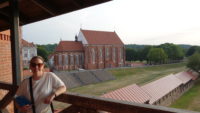 We worked our way back to the castle, which is now really a moat, some half-walls, and one tower. We walked around much of it and even climbed up into the tower to look about. There are seats built facing the moat in a couple of places, so I’m guessing the moat area is used for performances.
We worked our way back to the castle, which is now really a moat, some half-walls, and one tower. We walked around much of it and even climbed up into the tower to look about. There are seats built facing the moat in a couple of places, so I’m guessing the moat area is used for performances.
With that, we walked back to the hotel, tired but pleased with the day. Tomorrow, Mer takes over for planning, so we’ll see if her day comes together more easily than parts of mine did.
You would still be at the US/Canandian border if you were driving…